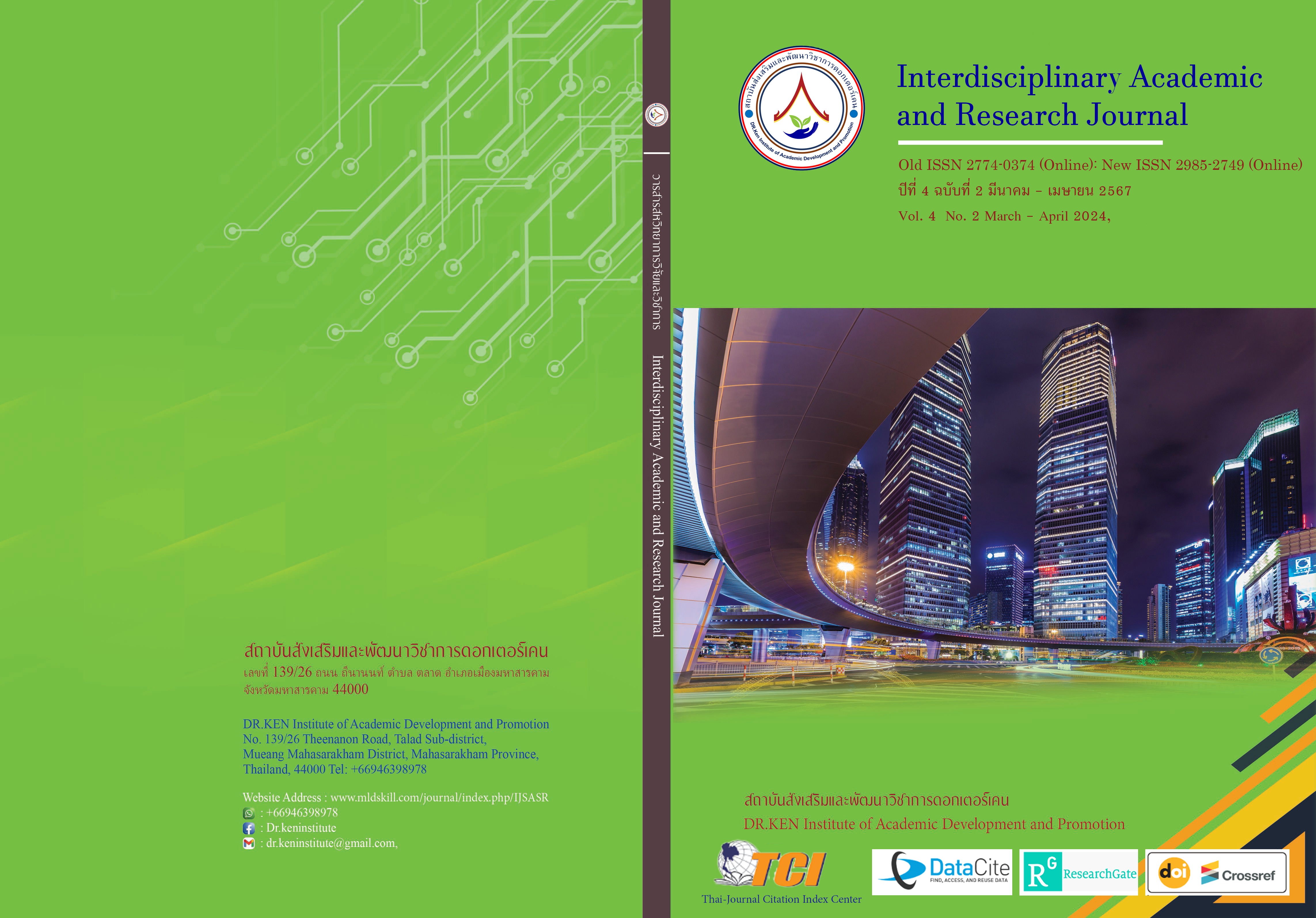The Development of Learning Activities based on 4 MAT to the Academic Achievement and Critical Thinking on Product and Service-Learning Units for Prathomsuksa 2 Students
DOI:
https://doi.org/10.60027/iarj.2024.274528Keywords:
4MAT Learning Management; , Learning Achievement; , Rhythmic Pacing StudentAbstract
Background and Aims: Analytical thinking can be said to be the basic idea for thinking in other dimensions. Analytical thinking allows us to know the facts, and the reasons behind what happened, and understand the history of various events. Analytical thinking is the separation of things to be considered into smaller, interrelated parts. The teaching activities using the 4MAT method teaching activity that takes into account the learning style and the functioning of both hemispheres of the learner's brain and allows the learner to practice student-focused analysis. It will give students the ability to think analytically. Thus, the objectives of this research were 1) to develop 4MAT learning activities on Products and services of Prathomsuksa 2 students to be effective according to the criteria 80/80. 2) To compare learning achievement Products and services learning units of Prathomsuksa 2 students learning using 4MAT learning activities. 3) To compare critical thinking abilities in the Products and Services Unit of Prathomsuksa 2 students learn using 4MAT learning activities.
Methodology: the sample includes: 2nd Prathomsuksa students Semester 1 Academic Year 2023 Ban Non-Rang School 28 People are obtained cluster random sampling, using schools as randomization units. Research instruments include a learning management plan using 4MAT learning management, academic achievement test, and cognitive ability test.
Results: the results of the research were as follows: (1) Efficiency of the management plan by using 4MAT learning activities Products and services for Prathomsuksa 2 Students effective 80.13/80.10. (2) Prathomsuksa 2 students learning using 4MAT learning activities have academic achievement after learning was statistically significantly higher than before the .05 level. And (3) Prathomsuksa 2 students learning using 4MAT learning activities have critical thinking ability after learning were statistically significantly higher than before the .05 level.
Conclusion: The research demonstrates that incorporating 4MAT learning activities into the management plan significantly enhances the efficiency of products and services for Prathomsuksa 2 students, achieving a notable effectiveness rating of 80.13/80.10. Moreover, the academic achievement and critical thinking abilities of Prathomsuksa 2 students exhibit statistically significant improvements after engaging in 4MAT learning activities, surpassing pre-intervention levels at the 0.05 significance level.
References
กระทรวงศึกษาธิการ. (2551). หลักสูตรแกนกลางการศึกษาขั้นพื้นฐานพุทธศักราช 2551.กกรุงเทพฯ : โรงพิมพ์ครุสภาลาดพร้าว.
กิตติยา ตาทิพย์. (2565). ผลการจัดการเรียนรู้แบบ 4MAT เรื่อง พฤติกรรมของสัตว์ที่มีต่อผลสัมฤทธิ์ทางการเรียนและความพึงพอใจต่อการจัดการเรียนรู้ของนักเรียน. วิทยานิพนธ์ครุศาสตรมหาบัณฑิต มหาวิทยาลัยราชภัฏอุตรดิตถ์.
เกรียงศักดิ์ เจริญวงศ์ศักดิ์. (2545). การจัดการเครือข่ายกลยุทธสู่ความสำเร็จของการปฏิรูปการศึกษา. กรุงเทพฯ : ซัคเซสมีเดีย.
นพมณี แสงทอง (2562). การใช้วิธีการสอนแบบ 4MAT เพื่อพัฒนาการอ่านคิดวิเคราะห์วรรณคดี และวรรณกรรมไทย สำหรับนักเรียนชั้นมัธยมศึกษาปีที่ 4. ปริญญานิพนธ์ครุศาสตรมหาบัณฑิต มหาวิทยาลัยราชภัฏอุตรดิตถ์
ปรียา ถาวีวร (2564) การพัฒนาการจัดกิจกรรมการเรียนรู้แบบ 4MAT กลุ่มสาระการเรียนรู้สังคมศึกษา ศาสนาและวัฒนธรรม สาระภูมิศาสตร์ สำหรับนักเรียนชั้นมัธยมศึกษาปีที่ 5. ปริญญานิพนธ์ครุศาสตรมหาบัณฑิต มหาวิทยาลัยราชภัฏสกลนคร.
พระมหากล้องนภา สิงห์ศร (2560). ผลการจัดการเรียนรู้แบบ 4MAT ที่มีต่อผลสัมฤทธิ์ทางการเรียนกลุ่มสาระการเรียนรู้สังคมศึกษา ศาสนา และวัฒนธรรมและแรงจูงใจใฝ่สัมฤทธิ์ของนักเรียนชั้น ประถมศึกษาปีที่ 5. มหาวิทยาลัยสงขลานครินทร์.
วิทวัฒน์ อันทะนัย. (2559). การพัฒนาความสามารถด้านการอ่านและการคิดวิเคราะห์ด้วยการเรียนรู้แบบ 4MAT ประกอบแผนผังความคิด กลุ่มสาระการเรียนรู้ภาษาไทยของนักเรียนชั้นประถมศึกษาปีที่ 5. วิทยานิพนธ์ การศึกษามหาบัณฑิต สาขาวิชาสังคมศึกษา. มหาสารคาม: มหาวิทยาลัยราชภัฏมหาสารคาม.
วิมลรัตน์ สุนทรโรจน์. (2544). เอกสารประกอบการเรียนการสอนวิชา 506703 การพัฒนาการสอนมหาสารคาม : ภาควิชาหลักสูตรและการสอน มหาวิทยาลัยมหาสารคาม.
ศรินยา แจ่มแจ้ง และคณะ (2563). ผลการจัดกิจกรรมการเรียน แบบ 4MAT เรื่องพื้นฐานทางเรขาคณิต ที่มีต่อผลสัมฤทธิ์ทางการเรียนคณิตศาสตร์ และเจตคติต่อการเรียนคณิตศาสตร์ ชั้นมัธยมศึกษาปีที่ 1 โรงเรียนเทศบาล 3 (สระกระเทียม). วารสารวิชาการมหาวิทยาลัยราชภัฏกาญจนบุรี, 9 (1), 1-12.
ศูนย์เครือข่ายพัฒนาคุณภาพแก้งสนามนาง 1. (2565). งานประกันคุณภาพ ฝ่ายวิชาการ. นครราชสีมา : ศูนย์เครือข่ายพัฒนาคุณภาพแก้งสนามนาง 1.
Dunn, R., & Griggs, S.A. (1995). Multigrade instruction and learning styles: Teaching and counseling adolescents. Praeger Publishers.
McCarthy, B. (2014). 4MAT in action: Sample units for the model. About Learning, Inc.
McCarthy, M. (1990). Using the 4MAT System to Bring Learning Styles to Schools. Educational Leadership. 48 (2), 31-37.
Nicoll-Senft, J. (2010). Assessing the Impact of the 4MAT Teaching Model Across Multiple Disciplines in Higher Education. College Teaching, 58(1), 19-27
Oltman, P.K., Klos, L.A., & Bovbjerg, D.H. (1997). A meta-analysis of the effect of 4MAT on student achievement. Educational and Psychological Measurement, 57(4), 659-669.
Stewart, M., & Felicetti, L. (1992). Teaching and learning in the middle grades. Allyn and Bacon.
Downloads
Published
How to Cite
Issue
Section
License
Copyright (c) 2024 Interdisciplinary Academic and Research Journal

This work is licensed under a Creative Commons Attribution-NonCommercial-NoDerivatives 4.0 International License.
Copyright on any article in the Interdisciplinary Academic and Research Journal is retained by the author(s) under the under the Creative Commons Attribution-NonCommercial-NoDerivatives 4.0 International License. Permission to use text, content, images, etc. of publication. Any user to read, download, copy, distribute, print, search, or link to the full texts of articles, crawl them for indexing, pass them as data to software, or use them for any other lawful purpose. But do not use it for commercial use or with the intent to benefit any business.
















.png)


